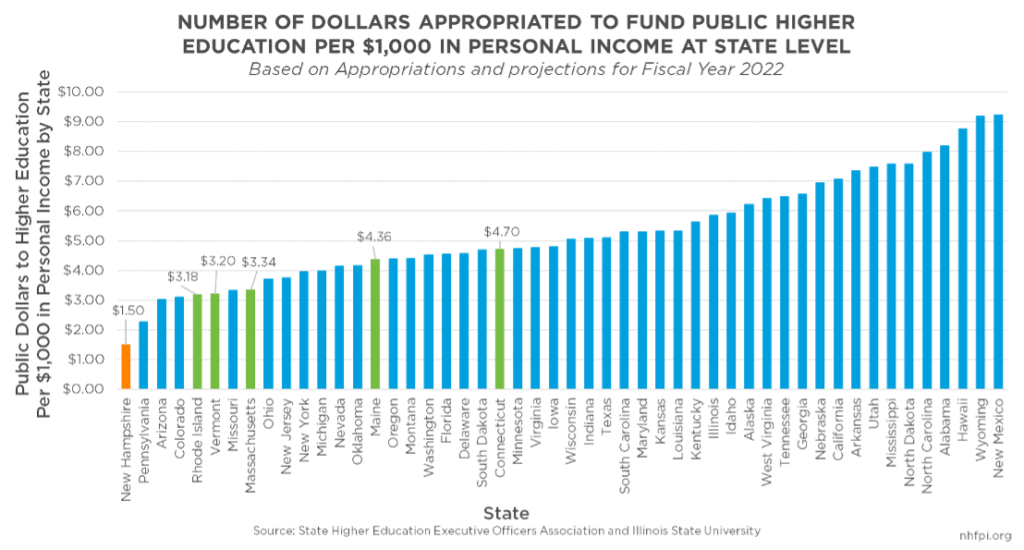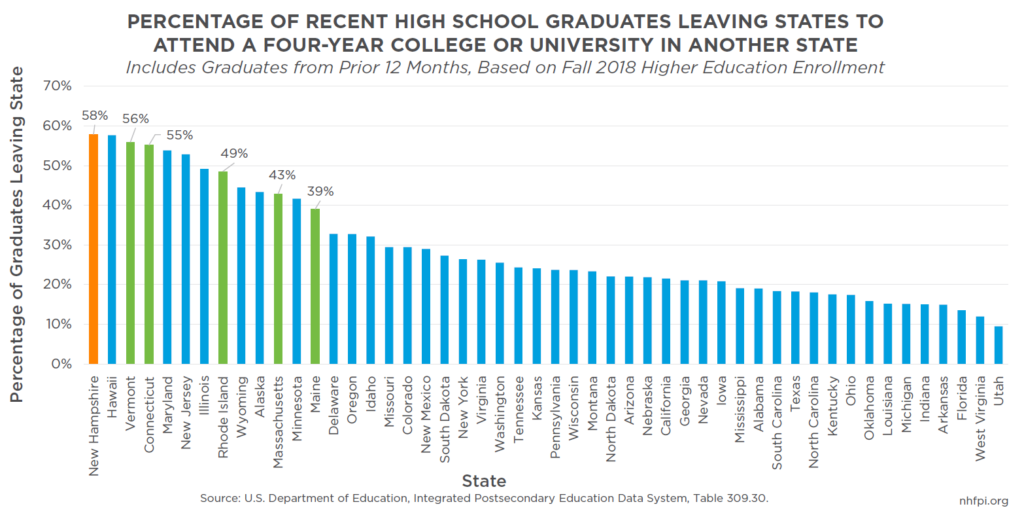State funding for public higher education in New Hampshire lags behind funding levels in most states even after recent increases in State support. Data collected from all fifty states show New Hampshire has the lowest level of state funding for public higher education on a per capita basis in fiscal year 2022. The State also has the lowest funding level of the fifty states relative to personal income. Interstate comparisons show students graduating from New Hampshire higher education institutions with debt have the highest average debt of any other state. Federal data also show New Hampshire had the highest percentage of recent high school graduates leaving the state to attend four-year institutions of any state in the Fall of 2018. Relatively low state public funding levels may make affording college more difficult for high school students who might otherwise seek to stay and obtain a degree in New Hampshire, which has implications for the growth of the state’s workforce and the well-being of Granite Staters.
Limited State Resources
Recent New Hampshire State Budgets have restored some funding for public higher education following significant reductions in support in State Fiscal Year (SFY) 2011. State General Fund support for the University System of New Hampshire, which operates the public four-year degree institutions based in the state, are at the highest levels since SFY 2011 in the current State Budget. The current State Budget also continued incremental increases in General Fund support for the Community College System of New Hampshire, which operates public institutions in the state granting two-year and technical degrees.
The changes in funding in recent State Budgets, including past one-time appropriations and enhanced operating grants, have increased State funding for public higher education relative to the low levels in the years immediately following the Great Recession of 2007-2009. Data collected by Illinois State University and the State Higher Education Executive Officers Association estimated a 15.9 percent increase in State financial support for public higher education in New Hampshire between fiscal years 2017 and 2022, which trailed the aggregate fifty state funding increase of 21.3 percent.
These same Illinois State University estimates indicated that New Hampshire fell behind all other states in two key metrics for funding of public higher education. The first measure is relative to state populations. For every person in New Hampshire, the State budgeted $106 for public higher education in fiscal year 2022. This value was the lowest amount of any state, and Pennsylvania was the next lowest state with $142 per capita funding for public higher education that year. Nationwide, state government support for public higher education averaged $318 per capita, and Wyoming had the highest level of funding by this metric, with $594 per capita.
The second key metric calculated with these data gauges state support for public higher education relative to personal income in the state. This indicator of relative ability to fund services measures the number of dollars used to fund public higher education per every $1,000 in personal income to the state’s residents. New Hampshire has the lowest amount of State funding for public higher education relative to personal income of any other state. The State government paid an estimated $1.50 for public higher education per every $1,000 in personal income during fiscal year 2022. Pennsylvania was again the next lowest at $2.26, while Arizona was the third lowest at $3.02, more than double New Hampshire’s level. The nationwide average was $5.12, and New Mexico had the most funding with $9.22 per $1,000 in personal income estimated for fiscal year 2022.
Measuring Outcomes and Consequences
Student decisions regarding whether, where, and when to seek out higher education are complex and affected by many factors, including financial considerations. While high school graduates and older adults may decide for non-financial reasons to not attend college or to leave the state to attend school elsewhere, cost considerations can still have significant and consequential impacts on the decisions of potential students.
Research from College Board indicates that New Hampshire has among the highest average public higher education tuition prices in the country. New Hampshire had the third-highest average published tuition and fees for in-district students among two-year public education institutions for the 2021-2022 academic year, behind only South Dakota and Vermont. Comparing all 50 states based on the average published tuition and fees for full-time in-state students attending four-year public institutions in the 2021-2022 school year, New Hampshire had the second-highest cost, at $17,040, behind only Vermont ($17,750). College Board reported an overall figure for the nation of $10,740, while Florida ($6,370) and Wyoming ($6,100) had the lowest costs. In College Board’s analysis, two states, North Dakota and South Dakota, had lower average four-year public institution tuition and fee costs for out-of-state students than New Hampshire had for in-state students.
These higher costs may have consequences for students long after they leave school. Student debt is the second-largest contributor to total debt nationally, after mortgages for homes. An annually-conducted analysis of student debt, published by the Institute for College Access and Success and based on surveys of institutions, found that students graduating from New Hampshire institutions had some of the highest average debt loads and were more likely to be in debt upon graduation. For graduates of both public and private institutions that grant bachelor’s degrees in New Hampshire from the class of 2020, approximately 70 percent of the students had debt upon graduation. That figure is the second highest of any state, suggesting New Hampshire students were more likely to graduate with debt than in other states. For students who had debt, New Hampshire had the highest average debt amount of any state, $39,928, a slightly larger amount than similar figures for Delaware and Pennsylvania. For comparison, the reported average debt was below $30,000 in 31 states. While these data only provide a limited insight based on voluntary survey responses of institutions, prior similar data collections have also shown New Hampshire-based institutions produce college graduates with the highest average debt loads in the country; these data continue to suggest that four-year students in New Hampshire are more likely to go into debt, and accrue more debt, than students in most other states.
New Hampshire high school students attending four-year institutions shortly after graduating are more likely to leave their home state to attend college than in any other state. While 74 percent of high school graduates attending a four-year college within 12 months of receiving their diploma nationwide remained in their home states for college in Fall 2018, data from the U.S. Department of Education show only 42 percent of New Hampshire high school graduates remained within the state’s borders to attend a four-year college, while 58 percent left the state. This percentage of students leaving was the highest of all 50 states, and slightly higher than the figure for Hawaii. Geography likely has a key role, as many states with smaller land areas lose a relatively high percentage of college-bound high school students to institutions in other states. However, other northeastern states that are geographically small relative to many states elsewhere in the country still lose a substantially smaller percentage of their four-year college-bound high school students, including Rhode Island (49 percent), Massachusetts (43 percent), Maine (39 percent), and Delaware (33 percent).
The relatively high cost of public higher education in New Hampshire is likely due in part to comparatively low levels of State support for institutions of higher education, and in turn may result in more Granite State high school students leaving New Hampshire for other educational opportunities than would have with the option of lower in-state tuition. Given the demographic trends that are impacting and will continue to impact New Hampshire’s economy and labor force, retaining young workers in the state is key for the state’s economic vibrancy and the future prosperity of all Granite Staters.
– Phil Sletten, Research Director


